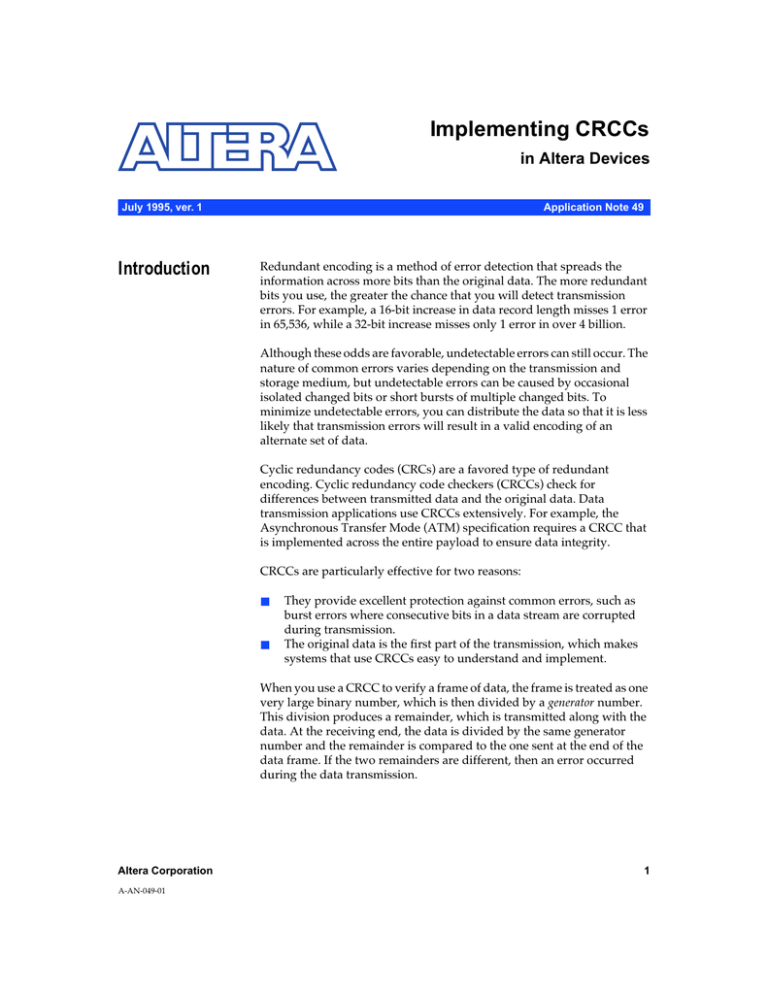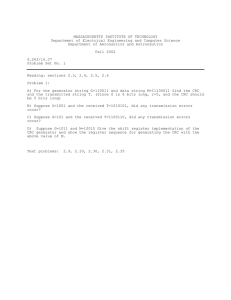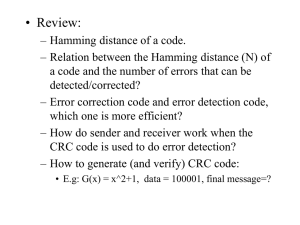
Implementing CRCCs
in Altera Devices
July 1995, ver. 1
Introduction
Application Note 49
Redundant encoding is a method of error detection that spreads the
information across more bits than the original data. The more redundant
bits you use, the greater the chance that you will detect transmission
errors. For example, a 16-bit increase in data record length misses 1 error
in 65,536, while a 32-bit increase misses only 1 error in over 4 billion.
Although these odds are favorable, undetectable errors can still occur. The
nature of common errors varies depending on the transmission and
storage medium, but undetectable errors can be caused by occasional
isolated changed bits or short bursts of multiple changed bits. To
minimize undetectable errors, you can distribute the data so that it is less
likely that transmission errors will result in a valid encoding of an
alternate set of data.
Cyclic redundancy codes (CRCs) are a favored type of redundant
encoding. Cyclic redundancy code checkers (CRCCs) check for
differences between transmitted data and the original data. Data
transmission applications use CRCCs extensively. For example, the
Asynchronous Transfer Mode (ATM) specification requires a CRCC that
is implemented across the entire payload to ensure data integrity.
CRCCs are particularly effective for two reasons:
■
■
They provide excellent protection against common errors, such as
burst errors where consecutive bits in a data stream are corrupted
during transmission.
The original data is the first part of the transmission, which makes
systems that use CRCCs easy to understand and implement.
When you use a CRCC to verify a frame of data, the frame is treated as one
very large binary number, which is then divided by a generator number.
This division produces a remainder, which is transmitted along with the
data. At the receiving end, the data is divided by the same generator
number and the remainder is compared to the one sent at the end of the
data frame. If the two remainders are different, then an error occurred
during the data transmission.
Altera Corporation
A-AN-049-01
1
AN 49: Implementing CRCCs in Altera Devices
Creating CRCCs
In general, digital logic does not implement the division of very large
numbers efficiently. Consequently, binary information must be converted
into a more appropriate form before CRCCs are used. The string of bits to
be verified is represented as the coefficients of a large polynomial, rather
than as a large binary number, as shown in the following example:
1,0001,0000,0010,0001 = X16 + X12 + X5 + 1
To make the calculations easier to implement, the arithmetic is cast in a
binary algebraic field. The arithmetic is implemented modulo 2 with no
carry, i.e., addition and subtraction are identical (implemented via XOR).
Multiplication by 1 or 0 is performed with an AND function, and division
by the binary field’s single non-zero element, 1, leaves the dividend
unchanged. In this system, any remainder for a polynomial of degree n is
no more than n –1 bits long. Therefore, even though polynomials of order
16 have 17 terms (including X0), any remainder is contained within 16 bits
(X15 through X0).
When implementing CRCCs, both the original data and the generator
number must be represented as polynomials. The generator number is
therefore called the generator polynomial. The polynomial that represents
the original data is multiplied by Xn, where n is the degree of the generator
polynomial (i.e., the length of the CRC). This operation shifts the data to
the left by n bits. The resulting 0s at the end of the polynomial allow you
to add the CRC to the data polynomial by replacing the last n bits (which
have become 0) with the CRC.
Since addition and subtraction are equivalent, this operation also
produces a polynomial that is evenly divisible by the generator
polynomial. Therefore, when the data polynomial plus the CRC is divided
by the generator polynomial at the receiving end of the system, the
remainder for an error-free transmission is always 0.
In summary, the data D is multiplied by Xn and divided by the generator
polynomial G. The quotient Q is then discarded, and the remainder R is
added to the dividend Xn × D. See the following equation:
(Xn × D) + R = (Q × G) + 0
At the receiving end, the first part of the transmitted information is the
original data D; the second part (the last n bits) is the remainder R. This
entire quantity is divided by the same generator polynomial G, and the
quotient Q is discarded. The remainder of this division is always 0 if there
are no errors in the transmitted data.
2
Altera Corporation
AN 49: Implementing CRCCs in Altera Devices
Error Detection
Generally, CRCCs detect the following types of errors:
■
■
■
■
■
Single-bit errors
Two-bit errors
Three-bit and other odd-number-bit errors
Burst errors that are less than or equal to the CRC length
Most burst errors that are greater than the CRC length
The types of errors that a CRCC detects depends on the generator
polynomial. Table 1 shows several common generator polynomials for
various applications.
Table 1. Common Generator Polynomials
Generator Name
Polynomial
CRC-16
X16 + X12 + X5 + X0
X16 + X11 + X4 + X0
X16 + X15 + X2 + X0
CRC-16 Reverse
X16 + X14 + X1 + X0
CRC-12
X12 + X11 + X3 + X2 + X1 + X0
Ethernet
X32 + X26 + X23 + X22 + X16 + X12 + X11 + X10 + X8 + X7 + X5 + X4 + X2 + X1 + X0
SDLC (CCITT)
SDLC Reverse
Different generator polynomials have different error-detection
capabilities. To achieve optimum results, you must use a generator
polynomial that effectively detects and corrects the expected transmission
errors. Alternatively, you can use a standard generator polynomial that is
appropriate for a particular transmission medium.
Serial CRC
Computation
Typically, CRC calculations are implemented with linear-feedback shift
registers (LFSRs). LFSRs use a method that yields the same results as the
subtract and shift division process when the subtraction is performed
without carry by the XOR function. To affect the subtract and shift division
one bit at a time, you can shift through and examine each bit in the original
frame of data (i.e., the dividend). For the first bit of value 1, the divisor
high-order bit is subtracted (XORed) from the dividend. That dividend
bit, which is unnecessary and is not generated, is set to zero by the
subtraction. The lower order bits of the divisor cannot be subtracted yet,
because the corresponding divisor bits have not been shifted in.
Altera Corporation
3
AN 49: Implementing CRCCs in Altera Devices
Figure 1 shows the Consultative Committee International Telegraph and
Telephone (CCITT) CRC-16 generator computed serially. The quotient
“1” bit (XOR16) is fed back and subtracted from the appropriate taps in the
shift register (XOR12, XOR5, XOR0). These bits shift forward to appear at the
end and are subtracted from the next data bit, unless they are eliminated
by a coinciding second bit from an earlier or later subtraction that is fed
back.
Figure 1. LFSR Configuration for CCITT CRC-16 Generator (X16 + X12 + X 5 + X 0)
XOR0
Register 15
Register 11
XOR5
D
Q
D
Q
Register 10
Register 4
XOR12
D
Q
D
Q
Register 3
Register 0
CRC Out
D
Q
D
Q
GND
XOR16
Data In
Parallel CRC
Computation
The serial method works well when the data is available in bit-serial form.
However, today’s high-speed signal processing systems process data in
byte, word, double-word (32-bit), or larger widths rather than serially.
Even in telecommunications systems, which transmit data serially,
received data is encapsulated within a VLSI device responsible for Clock
recovery and byte framing. The data is presented to the board designer in
8-bit frames at a manageable speed. Therefore, designs for high-speed
devices require the CRC to be calculated 8 bits at a time.
You can develop a parallel CRC algorithm with the LFSR approach. You
can express the contents of the shift register after 8 shifts as a function of
the initial contents of the shift register and the 8 data bits shifted in. This
function can be created using only XOR operators. Figure 2 shows the
function that uses the CCITT CRC-16 generator polynomial (X16 + X12 +
X5 + X0). In this example, the register contents C[15..0] and the next 8
data bits D[7..0] are used to calculate the general contents of the register
after 8 shifts. Because the register shifts once for each input data bit, the
XOR16 operator produces the series of terms C0 ⊕ D0, C1 ⊕ D1, etc. These
terms are assigned the name M n where M n = C n ⊕ Dn.
4
Altera Corporation
AN 49: Implementing CRCCs in Altera Devices
Figure 2. CRC Register Shifts for CCITT CRC-16 Generator (X16 + X12 + X 5 + X 0)
All terms on a line are XORed together.
XOR16
XOR16
XOR16
D1
D0
M1
D4
CRC register
after 8 shifts
XOR16
M4 ⊕ M0
D5
M5 ⊕ M1
C5
C6
C7
C8
C9
C10
C11
C12
C13
C14
C15
M1
M2
M3
M4
M0
Reg0
Reg1
Reg2
Reg3
Reg4
Reg5
Reg6
Reg7
Reg8
Reg9
Reg10
Reg11
Reg12
Reg13
Reg14
Reg15
C0
C1
C2
C3
C4
C5
C6
C7
C8
C9
C10
C11
C12
C13
C14
C15
C1
C2
C3
C4
C5
C6
C7
C8
C9
C10
C11
C12
C13
C14
C15
M0
M0
M0
M1
M2
M3
Shift 1
M0
M0
M1
M2
M3
M4
M0
M1
M2
M3
M4
M0
M1
M2
M3
M0
Shift 0
M0
M1
M2
M3
C4
C5
C6
C7
C8
C9
C10
C11
C12
C13
C14
C15
Shift 4
Shift 5
M0
M0
C8
C9
C10
C11
C12
C13
C14
C15
M4
M5
M6
M0 M7
M1
M2
M3
M4
M0 M5
M1 M6
M2 M7
M3
M4
M5
M6
M7
M0
M1
M2
M3
M0
M1
M2
M3
M0
M1
M2
M3
Shift 8
On the first four shifts, only Mn terms are fed back. On the fifth shift,
register 0 now contains C4 ⊕ M0(from earlier shifts), which will be XORed
with D4 and fed back, as shown in the following equation:
D4 ⊕ (C4 ⊕ M0) = (D4 ⊕ C4) M0 = M4 ⊕ M0
Later shifts all have multiple terms fed back. The CRC register contents
after 8 shifts are shown in the box on the right.
AHDL CRC
Macrofunction
Altera Corporation
Figure 3 shows an excerpt from an Altera Hardware Description
Language (AHDL) Text Design File (.tdf) that includes the logic equations
for the register values after 8 shifts (i.e., 1 byte later).
5
AN 49: Implementing CRCCs in Altera Devices
Figure 3. AHDL CRC Design Excerpt
ex0
ex1
ex2
ex3
ex4
ex5
ex6
ex7
=
=
=
=
=
=
=
=
(
(
(
(
(
(
(
(
reg[0]
reg[1]
reg[2]
reg[3]
reg[4]
reg[5]
reg[6]
reg[7]
reg[0].d
reg[1].d
reg[2].d
reg[3].d
reg[4].d
reg[5].d
reg[6].d
reg[7].d
reg[8].d
reg[9].d
reg[10].d
reg[11].d
reg[12].d
reg[13].d
reg[14].d
reg[15].d
1
=
=
=
=
=
=
=
=
=
=
=
=
=
=
=
=
$
$
$
$
$
$
$
$
dat[0]
dat[1]
dat[2]
dat[3]
dat[4]
dat[5]
dat[6]
dat[7]
reg[8]
reg[9]
reg[10]
reg[11]
reg[12]
reg[13]
reg[14]
reg[15]
)
)
)
)
)
)
)
)
;
;
;
;
;
;
;
;
$
$
$
$
$
ex0 $
ex1 $
ex2 $
ex3
ex4
ex5
ex6
ex7
$
$
$
ex0 $
ex1
ex2
ex3
ex4
ex5
ex6
ex7
ex4
ex5
ex6
ex7
$
$
$
$
ex0
ex1
ex2
ex3
$
$
$
$
ex0
ex1
ex2
ex3
$
$
$
$
ex0
ex1
ex2
ex3
;
;
;
;
;
;
;
;
;
;
;
;
;
;
;
;
A complete AHDL description of the CCITT CRC-16
macrofunction is available in the self-extracting file an_049.exe
from the Altera bulletin board service (BBS) at (408) 954-0104 or
from Altera’s FTP site.
A CRC is calculated before a frame of data is transmitted, then each data
byte is clocked into the CRC macrofunction. Conversely, the CRC is
clocked during each byte of transmitted data. After the last byte of data is
clocked in, the 16-bit CRC is appended to the data. A multiplexer selects
the low CRC byte (REG[7..0]), then selects the high byte for
transmission.
6
Altera Corporation
AN 49: Implementing CRCCs in Altera Devices
To check the CRC after the data transmission, you should clear the shift
register by asserting the Clear signal. The CRC macrofunction is enabled
for one Clock cycle during each byte of received data, including the two
CRC bytes calculated at transmission end and appended to the end of the
data frame. After the last CRC byte is clocked in, the register contains the
16-bit CRC of the transmitted data plus the transmitted CRC, as shown in
the following equation:
n
X ×D+R
--------------------------G
If there are no errors in the transmission, the remainder is 0, and the CRC00
signal is asserted.
Piecewise
CRCC
Computation
In packet-switching networks (such as ATM networks), a frame is broken
into small packets for transmission, then reassembled into the original
long frame after it is received. The frame can include a CRC at the end that
allows the CRCC to verify the integrity of the entire frame once it is
reassembled. It is easier to generate a CRC while the frame is still in its
original format. For more complex transmission protocols, CRC
generation may require a communications processor, which can easily
become overburdened. To avoid the need for a communications processor
entirely, you can compute the CRC in hardware at a lower level.
However, his method can cause packets from different frames to
intermingle, especially on the receiving end.
To prevent intermingling frames, you can compute the CRC for each
packet separately, i.e., piecewise. Once the CRCC has been executed over
a packet, the interim CRC is stored in a small RAM that is indexed by the
channel number. For the next packet, the channel number is first
determined from the header, and the interim CRC for the previous
channel is extracted from the RAM and loaded into the CRC register. The
packet’s data is then clocked into the CRC. At the end of the packet, the
interim CRC for the next packet is stored in the RAM in preparation for
the next packet. Sometimes the data path needs to be delayed by a few
bytes to allow cycles to acquire the channel number and load the previous
interim CRC into the CRC macrofunction. When the last packet of a frame
is transmitted, the CRC is appended to the data so that it can be verified
as 0 when it is received.
The piecewise method adds RAM and control logic to the design.
However, this method has little effect on the CRC engine; the register
must simply be loaded with the interim CRC for the previous channel
before proceeding with each packet’s data.
Altera Corporation
7
AN 49: Implementing CRCCs in Altera Devices
1
A sample file of the CRC macrofunction with an added load
function is available in the self-extracting file an_049.exe from
the Altera bulletin board service (BBS) at (408) 954-0104 or from
Altera’s FTP site.
Each frame’s packets must be processed in the same order at transmission
and reception. If any of the packets are out of sequence when they are
received, the CRCC indicates an error. Bit or burst errors are also detected
and reported.
Conclusion
CRCCs are an efficient method for verifying data transmission, especially
for ATM applications. CRCCs offer protection from common errors
without adding extensive logic overhead. You can use either serial or
parallel computation methods to implement CRCCs. For applications in
which the data frame is segmented and mixed with data from other
frames, a piecewise CRC calculation is most effective.
Bibliography
Hamming, R.W. Coding and Information Theory. Prentice-Hall, 1980.
Lee, R. “Cyclic Code Redundancy.” Digital Design, 7/81.
Perez, A. “Byte-wise CRC Calculations.” IEEE MICRO, 6/83.
Peterson, W.W., and Brown, D.T. “Cyclic Codes for Error Detection.” Proc.
IRE, 1/61.
Peterson, W.W. and Weldon, E.J. Error-Correcting Codes. MIT Press, 1961.
Pless, Vera. Introduction to the Theory of Error-Correcting Codes. John
Wiley & Sons, 1982.
Ramabadran, T.V. and Gaitonde, S.S. “A Tutorial on CRC Computations.”
IEEE MICRO, 8/88.
2610 Orchard Parkway
San Jose, CA 95134-2020
(408) 894-7000
Applications Hotline:
(800) 800-EPLD
Customer Marketing:
(408) 894-7104
Literature Services:
(408) 894-7144
8
Altera, MAX, MAX+PLUS, FLEX, and FLEX Ability are registered trademarks of Altera Corporation. The
following are trademarks of Altera Corporation: MAX+PLUS II, AHDL. Altera acknowledges the trademarks
of other organizations for their respective products or services mentioned in this document. Altera products
marketed under trademarks are protected under numerous U.S. and foreign patents and pending applications,
maskwork rights, and copyrights. Altera warrants performance of its semiconductor products to current
specifications in accordance with Altera’s standard warranty, but reserves the right to make changes to any
products and services at any time without notice. Altera assumes no responsibility or liability arising out of
the application or use of any information, product, or service described herein except as expressly agreed to in
writing by Altera Corporation. Altera customers are advised to obtain the latest version of
device specifications before relying on any published information and before placing
orders for products or services.
U.S. and European patents pending.
Copyright 1995 Altera Corporation. All rights reserved.
Altera Corporation
Printed on Recycled Paper.




